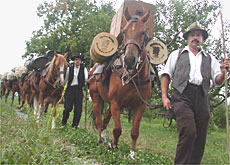
Old alpine trading route revived

Several dozen hikers with a weakness for historical re-enactments have revived an old alpine trading route.
They spent a week doing what traders did for centuries – leading pack animals laden with salt and cheese over a series of mountain passes.
Some of the party turned up in authentic costume, and one of them – Ludwig Degelo – even sported a pair of hobnail boots.
He said they gave him a good grip and quite literally put him in the shoes of the early traders in whose footsteps he was following.
“I wanted to discover the world when I was young so I did a lot of travelling,” said Degelo, as he set out with the horse train to cross the first of three alpine passes along the “Sbrinz Route”.
“But now I want to get back to my roots and rediscover my Swiss heritage.”
Forgotten route
Degelo is a mechanical engineer by profession and a member of the historical society of Giswil in central Switzerland, which was also the starting point for the week-long journey.
The society is one of the driving forces behind the re-enactment, designed to rekindle interest in an almost forgotten trading route and to promote tourism in the places it passes through.
Before the completion of the Gotthard railway tunnel through the Alps in the 1880s, north-south trade was conducted by men called sumpters, who for centuries crossed alpine passes, braving the elements, banditry, extortionate tolls and disease.
Volumes have been written about the trade conducted over the Gotthard route, as well as the Simplon and Great St Bernard passes, but little about the ancient route being retraced by modern-day sumpters.
Salt and cheese
On this route, men were hired to transport salt and hard Sbrinz cheese from central Switzerland to Val Formazza in Italy, which meant crossing three passes – the Brünig, Grimsel and Gries.
They returned with wine, spices and textiles.
“Compared with traders following the Gotthard route, the sumpters travelling between Giswil and Val Formazza were not bound by many regulations,” explained amateur historian Remigius Küchler.
As part of the re-enactment, Küchler was commissioned to write a book on the Sbrinz route, “Canton Obwalden’s Route to the South” (in German).
“Another reason there are few surviving documents is because business along this route was conducted almost without incident, so little was written down,” he added.
Historical puzzle
Through painstaking research, Küchler was able to find the missing pieces of a complex historical puzzle to finally give the ancient traders of the Sbrinz route their due.
Using Küchler’s book as their bible, the organisers were able to make the re-enactment as authentic as possible.
They also received valuable support from elsewhere: the Swiss army provided the horse train; tourism officials took care of promotion; and the Sbrinz Cheese Company supplied the cheese.
Petra Tobler-Arnold, head of marketing at Sbrinz, admitted that the revival of the Sbrinz route offered an opportunity for the company to improve the image of Sbrinz in Switzerland and abroad.
“Sales have really died over the last 30 to 40 years,” said Tobler-Arnold.
Sbrinz cheese
Once a sought-after product in northern Italy – as proven by Küchler’s findings – Sbrinz cheese has suffered in recent decades.
“We used to produce 8,000 tons annually, but now we are down to 2,000 tons.”
A small percentage of what is produced is still exported to Italy, but even the Swiss prefer the Italian equivalent, Parmesan, importing 8,000 tons a year.
There was ample Sbrinz cheese to taste at each stop made by the horse train along the old route – through canton Obwalden, the Hasli Valley and the Goms region of canton Valais.
At journey’s end, in Val Formazza, the sumpters symbolically exchanged the cheese and salt for wine, spices and textiles as their forefathers once did.
There are no immediate plans for another re-enactment, but the old trading route has now been signposted for anyone wishing to follow in the footsteps of the old sumpters.
swissinfo, Dale Bechtel in Giswil
About 100 people and 20 horses took part in the re-enactment, transporting salt and Sbrinz hard cheese. The salt came from Tyrol, and was considered of a better quality than the sea salt available in Italy.
The “Sbrinz” north-south trade route was first used in the early 15th century.
The traders and their pack animals were replaced by the railways when the first north-south alpine tunnel was completed in the 1880s.
The organisers carried out the re-enactment to highlight the historical importance of the route, to boost tourism in the towns and villages along the route and improve the image of Sbrinz cheese.
The route is now signposted for hikers and organised tours can be arranged through the local tourist offices.
An accompanying exhibition (in German) can be seen in the canton Obwalden town of Giswil until the end of August.

In compliance with the JTI standards
More: SWI swissinfo.ch certified by the Journalism Trust Initiative






























You can find an overview of ongoing debates with our journalists here . Please join us!
If you want to start a conversation about a topic raised in this article or want to report factual errors, email us at english@swissinfo.ch.